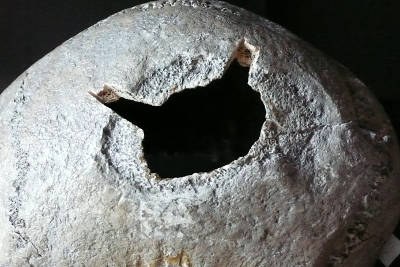Permanent exhibition – Human as a part of nature
What is the difference between humans and other species? Was the human evolution influenced by climatic conditions? Is there any difference between a man and a woman? What happens to the human body after death? You only need to ask and you will learn even more!
The exhibition consists of several collections, which can be found in two exhibition rooms. The concept of the exhibition corresponds with the initial concept of Dr. Ales Hrdlicka. It is exceptional, as you can find something new, which was not noticed before, every time. You can come any time during opening hours, we provide commentary for tours of groups of 6+. The tour with commentary takes up to 90 minutes and it can be held out of opening hours on request.
Human evolution
Did humans exist before the modern man? Thanks to the collection of 3D models of skulls and skeletals remains you can see different human species, ancestors and related species – from Australopithecus to a modern human. Models were made in accordance to real fossils. In following the zoological part of exhibition, you get to see the difference between man and man’s closest relatives – apes.
Trephinated skull collection
Trephination is an operation when the skull is opened. When, where and why was trephination happening? Has this operation been carried out to the present day? Can we confirm if the patient could survive this operation? Even you will learn how to answer these questions with the help of real trephinated skulls.
Phrenologic collection
Phrenologists believe people are already born possesing character and abilities. And not only that – they believe that you can say what character and abilities human poses by certain lines, dimples or protuberancies on the human head or skull. Do you think they would say you are fun, talented in science or would they jail you just in case because you have signs of a typical criminal?
Šebesta collection
Czech anthropologist Pavel Šebesta visited Pygmies (people so short that even their brave adult hunters reached only up to waist of the ordinary European) in the African rainforest. Pygmies are interesting not only for they stature as you will find out yourself as you explore our casts of faces, hands, feet and hair samples.
Death masks
With the advent of death masks being developed, you now can meet many famous artists, scientists and politicians. Did Jan Masaryk look like his father T. G. Masaryk? Would you befriend J. E. Purkyne, Ludwig van Beethoven, Antonin Dvorak or Frana Sramek? Find out for yourself.
Hrdlicka and Maly Collection
In 1912, Ales Hrdlicka sent to Czech anthropologists, busts of important Indian chiefs from the USA. These inspired even the famous Czech artist Zdenek Burian. You can meet Standing Cloud, Crabbing Bear or I-te-a-za-za here.
Paleopathology Collection
When finding a skeleton, there are basic questions to answer: Is it a man or a woman? What was the age of him or her when he or she died? You don’t need to study anthropology to be able to answer those questions. Collection of human remains from 16th to 18th century will gain insight into these topics.
Egyptian Collection
In the smaller of the two exhbition rooms you can find three mummies from Deir el-Medina. As well as they being 3000 year old mummies, you can also see exhibits associated with the topic of death. Ancient Egyptians believed that the human body after death must stay preserved and intact to be able to join the afterlife. That is why funeral rituals were so important to them.
Foit Collection
Have you ever seen artificially deformed skulls? There were always ethnic groups that considered the natural shape of the skull not aestethical and therefore tried to deform skulls of their children by using different tablets or dressings. Academic painter Foita’s collection shows an artistic representation of African tribes‘ life (pele-pele, mutilations, sculptures).








